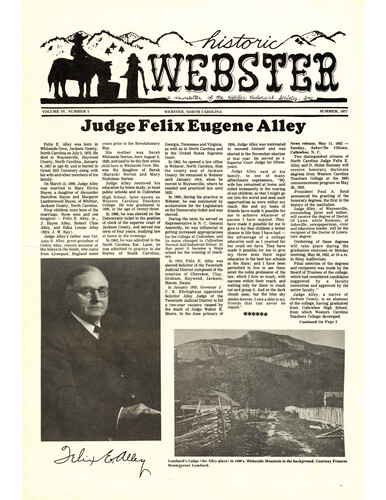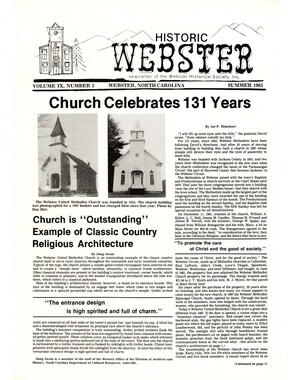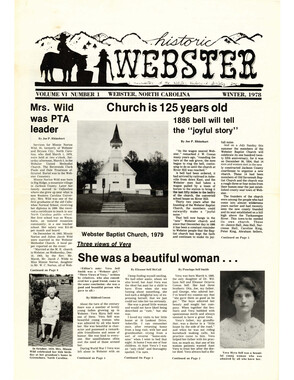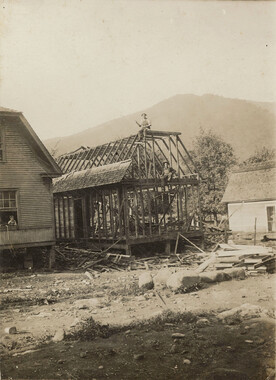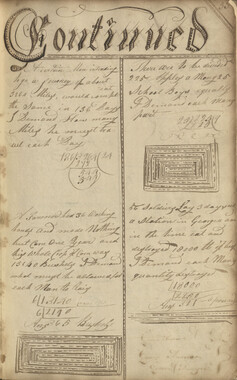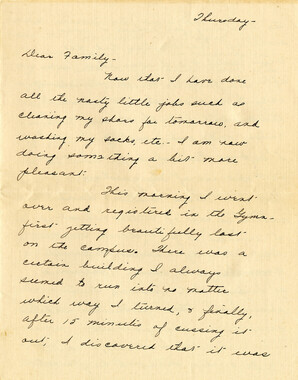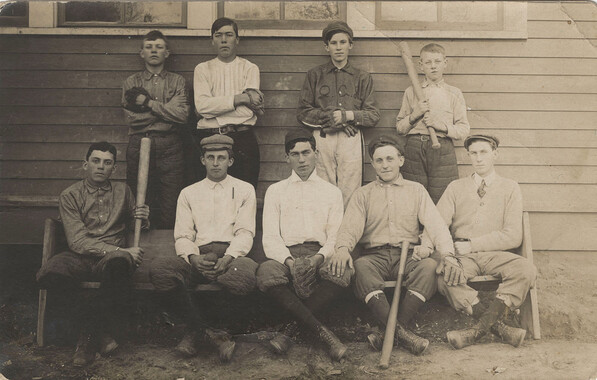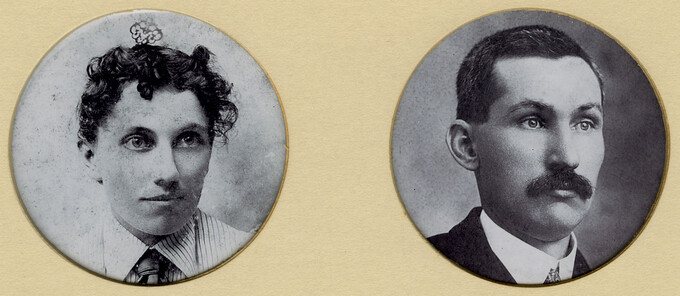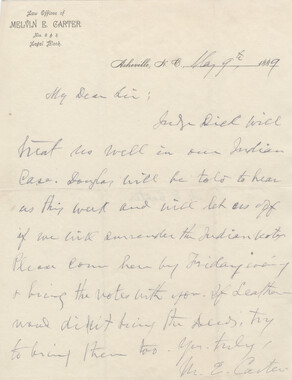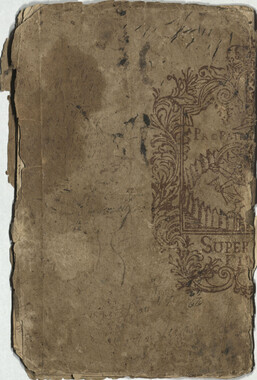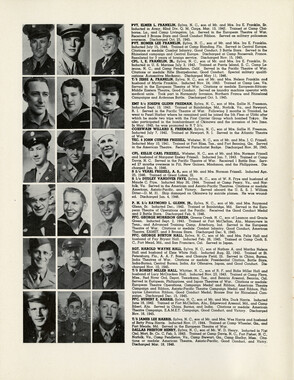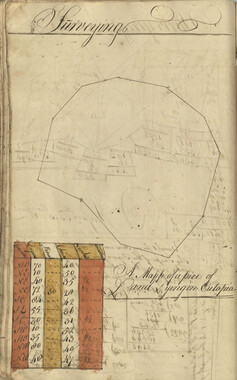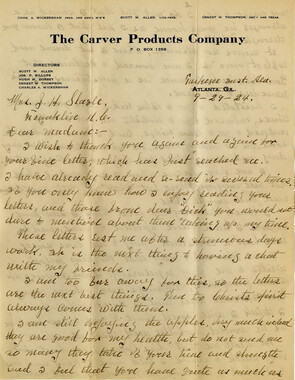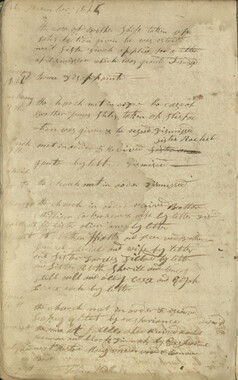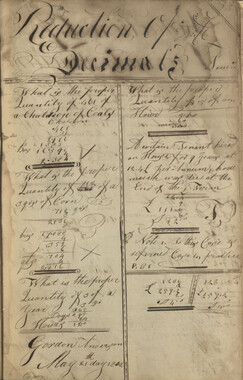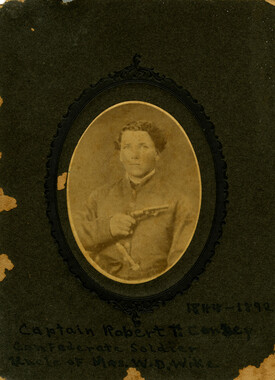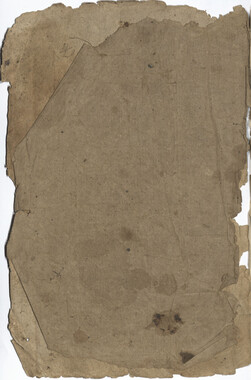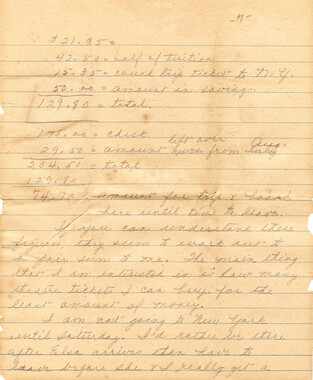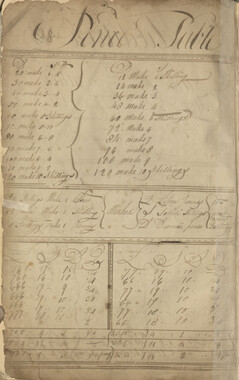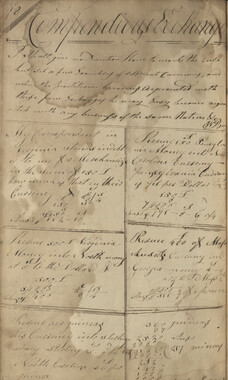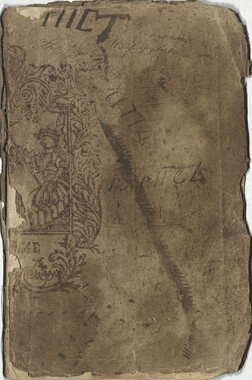Western Carolina University (20)
View all
- Canton Champion Fibre Company (2308)
- Cherokee Traditions (292)
- Civil War in Southern Appalachia (165)
- Craft Revival (1942)
- Great Smoky Mountains - A Park for America (2766)
- Highlights from Western Carolina University (430)
- Horace Kephart (941)
- Journeys Through Jackson (154)
- LGBTQIA+ Archive of Jackson County (85)
- Oral Histories of Western North Carolina (314)
- Picturing Appalachia (6772)
- Stories of Mountain Folk (413)
- Travel Western North Carolina (160)
- Western Carolina University Fine Art Museum Vitreograph Collection (129)
- Western Carolina University Herbarium (92)
- Western Carolina University: Making Memories (708)
- Western Carolina University Publications (2283)
- Western Carolina University Restricted Electronic Theses and Dissertations (146)
- Western North Carolina Regional Maps (71)
- World War II in Southern Appalachia (131)
University of North Carolina Asheville (6)
View all
- Allanstand Cottage Industries (62)
- Appalachian National Park Association (53)
- Bennett, Kelly, 1890-1974 (1388)
- Berry, Walter (76)
- Brasstown Carvers (40)
- Carver, George Washington, 1864?-1943 (26)
- Cathey, Joseph, 1803-1874 (1)
- Champion Fibre Company (233)
- Champion Paper and Fibre Company (297)
- Cherokee Indian Fair Association (16)
- Cherokee Language Program (22)
- Crowe, Amanda (40)
- Edmonston, Thomas Benton, 1842-1907 (7)
- Ensley, A. L. (Abraham Lincoln), 1865-1948 (275)
- Fromer, Irving Rhodes, 1913-1994 (70)
- George Butz (BFS 1907) (46)
- Goodrich, Frances Louisa (120)
- Grant, George Alexander, 1891-1964 (96)
- Heard, Marian Gladys (60)
- Kephart, Calvin, 1883-1969 (15)
- Kephart, Horace, 1862-1931 (313)
- Kephart, Laura, 1862-1954 (39)
- Laney, Gideon Thomas, 1889-1976 (439)
- Masa, George, 1881-1933 (61)
- McElhinney, William Julian, 1896-1953 (44)
- Niggli, Josephina, 1910-1983 (10)
- North Carolina Park Commission (105)
- Osborne, Kezia Stradley (9)
- Owens, Samuel Robert, 1918-1995 (11)
- Penland Weavers and Potters (36)
- Roberts, Vivienne (15)
- Roth, Albert, 1890-1974 (142)
- Schenck, Carl Alwin, 1868-1955 (1)
- Sherrill's Photography Studio (2565)
- Southern Highland Handicraft Guild (127)
- Southern Highlanders, Inc. (71)
- Stalcup, Jesse Bryson (46)
- Stearns, I. K. (213)
- Thompson, James Edward, 1880-1976 (226)
- United States. Indian Arts and Crafts Board (130)
- USFS (683)
- Vance, Zebulon Baird, 1830-1894 (1)
- Weaver, Zebulon, 1872-1948 (58)
- Western Carolina College (230)
- Western Carolina Teachers College (282)
- Western Carolina University (1794)
- Western Carolina University. Mountain Heritage Center (18)
- Whitman, Walt, 1819-1892 (10)
- Wilburn, Hiram Coleman, 1880-1967 (73)
- Williams, Isadora (3)
- Cain, Doreyl Ammons (0)
- Crittenden, Lorraine (0)
- Rhodes, Judy (0)
- Smith, Edward Clark (0)
- Appalachian Region, Southern (2569)
- Asheville (N.C.) (1923)
- Avery County (N.C.) (26)
- Blount County (Tenn.) (161)
- Buncombe County (N.C.) (1672)
- Cherokee County (N.C.) (283)
- Clay County (N.C.) (555)
- Graham County (N.C.) (233)
- Great Smoky Mountains National Park (N.C. and Tenn.) (519)
- Haywood County (N.C.) (3524)
- Henderson County (N.C.) (70)
- Jackson County (N.C.) (4694)
- Knox County (Tenn.) (25)
- Knoxville (Tenn.) (12)
- Lake Santeetlah (N.C.) (10)
- Macon County (N.C.) (420)
- Madison County (N.C.) (212)
- McDowell County (N.C.) (39)
- Mitchell County (N.C.) (132)
- Polk County (N.C.) (35)
- Qualla Boundary (981)
- Rutherford County (N.C.) (76)
- Swain County (N.C.) (2115)
- Transylvania County (N.C.) (270)
- Watauga County (N.C.) (12)
- Waynesville (N.C.) (84)
- Yancey County (N.C.) (72)
- Aerial Photographs (3)
- Aerial Views (60)
- Albums (books) (4)
- Articles (1)
- Artifacts (object Genre) (228)
- Bibliographies (1)
- Biography (general Genre) (2)
- Cards (information Artifacts) (38)
- Clippings (information Artifacts) (191)
- Crafts (art Genres) (622)
- Depictions (visual Works) (21)
- Design Drawings (1)
- Drawings (visual Works) (184)
- Envelopes (73)
- Facsimiles (reproductions) (1)
- Fiction (general Genre) (4)
- Financial Records (12)
- Fliers (printed Matter) (67)
- Glass Plate Negatives (381)
- Guidebooks (2)
- Internegatives (10)
- Interviews (815)
- Land Surveys (102)
- Letters (correspondence) (1013)
- Manuscripts (documents) (618)
- Maps (documents) (177)
- Memorandums (25)
- Minutes (administrative Records) (59)
- Negatives (photographs) (5835)
- Newsletters (1285)
- Newspapers (2)
- Occupation Currency (1)
- Paintings (visual Works) (1)
- Pen And Ink Drawings (1)
- Periodicals (193)
- Personal Narratives (10)
- Photographs (12976)
- Plans (maps) (1)
- Poetry (6)
- Portraits (4533)
- Postcards (329)
- Programs (documents) (151)
- Publications (documents) (2236)
- Questionnaires (65)
- Scrapbooks (282)
- Sheet Music (2)
- Slides (photographs) (402)
- Songs (musical Compositions) (2)
- Sound Recordings (796)
- Specimens (92)
- Speeches (documents) (15)
- Tintypes (photographs) (8)
- Transcripts (322)
- Video Recordings (physical Artifacts) (23)
- Vitreographs (129)
- Text Messages (0)
- A.L. Ensley Collection (275)
- Appalachian Industrial School Records (7)
- Appalachian National Park Association Records (336)
- Axley-Meroney Collection (2)
- Bayard Wootten Photograph Collection (20)
- Bethel Rural Community Organization Collection (7)
- Blumer Collection (5)
- C.W. Slagle Collection (20)
- Canton Area Historical Museum (2110)
- Carlos C. Campbell Collection (282)
- Cataloochee History Project (64)
- Cherokee Studies Collection (4)
- Daisy Dame Photograph Album (5)
- Daniel Boone VI Collection (1)
- Doris Ulmann Photograph Collection (112)
- Elizabeth H. Lasley Collection (1)
- Elizabeth Woolworth Szold Fleharty Collection (4)
- Frank Fry Collection (95)
- George Masa Collection (173)
- Gideon Laney Collection (452)
- Hazel Scarborough Collection (2)
- Hiram C. Wilburn Papers (28)
- Historic Photographs Collection (236)
- Horace Kephart Collection (861)
- Humbard Collection (33)
- Hunter and Weaver Families Collection (1)
- I. D. Blumenthal Collection (4)
- Isadora Williams Collection (4)
- Jesse Bryson Stalcup Collection (47)
- Jim Thompson Collection (224)
- John B. Battle Collection (7)
- John C. Campbell Folk School Records (80)
- John Parris Collection (6)
- Judaculla Rock project (2)
- Kelly Bennett Collection (1407)
- Love Family Papers (11)
- Major Wiley Parris Civil War Letters (3)
- Map Collection (12)
- McFee-Misemer Civil War Letters (34)
- Mountain Heritage Center Collection (4)
- Norburn - Robertson - Thomson Families Collection (44)
- Pauline Hood Collection (7)
- Pre-Guild Collection (2)
- Qualla Arts and Crafts Mutual Collection (12)
- R.A. Romanes Collection (681)
- Rosser H. Taylor Collection (1)
- Samuel Robert Owens Collection (94)
- Sara Madison Collection (144)
- Sherrill Studio Photo Collection (2558)
- Smoky Mountains Hiking Club Collection (616)
- Stories of Mountain Folk - Radio Programs (374)
- The Reporter, Western Carolina University (510)
- Venoy and Elizabeth Reed Collection (16)
- WCU Gender and Sexuality Oral History Project (32)
- WCU Mountain Heritage Center Oral Histories (25)
- WCU Oral History Collection - Mountain People, Mountain Lives (71)
- WCU Students Newspapers Collection (1744)
- Western North Carolina Tomorrow Black Oral History Project (69)
- William Williams Stringfield Collection (2)
- Zebulon Weaver Collection (109)
- African Americans (390)
- Appalachian Trail (35)
- Artisans (521)
- Cherokee art (84)
- Cherokee artists -- North Carolina (10)
- Cherokee language (21)
- Cherokee pottery (101)
- Cherokee women (208)
- Church buildings (170)
- Civilian Conservation Corps (U.S.) (110)
- College student newspapers and periodicals (1830)
- Dams (107)
- Dance (1023)
- Education (222)
- Floods (61)
- Folk music (1015)
- Forced removal, 1813-1903 (2)
- Forest conservation (220)
- Forests and forestry (1184)
- Gender nonconformity (4)
- Great Smoky Mountains National Park (N.C. and Tenn.) (181)
- Hunting (38)
- Landscape photography (25)
- Logging (118)
- Maps (83)
- Mines and mineral resources (8)
- North Carolina -- Maps (18)
- Paper industry (38)
- Postcards (255)
- Pottery (135)
- Railroad trains (71)
- Rural electrification -- North Carolina, Western (3)
- School integration -- Southern States (2)
- Segregation -- North Carolina, Western (5)
- Slavery (5)
- Sports (452)
- Storytelling (244)
- Waterfalls -- Great Smoky Mountains (N.C. and Tenn.) (66)
- Weaving -- Appalachian Region, Southern (280)
- Wood-carving -- Appalachian Region, Southern (328)
- World War, 1939-1945 (173)
Historic Webster Vol. 4 No. 3
-
Historic Webster is a newsletter of the Webster Historical Society, Inc., created at the Society’s founding in 1974. The publication helped to serve the Society's mission of collecting and preserving the history of Webster, North Carolina. Webster, established in 1851, was the original county seat for Jackson County.
-
-
WEBSTER, NORTH CAROLINA SUMMER, 1977 Judge Felix Eugene Alley Felix E. Alley was born in Whiteside Cove, Jackson County, North Carolina on July 5, 1873. He died in Waynesville, Haywood County, North Carolina, January 6, 1957 at age 83, and is buried in Green Hill Cemetery along with his wife and other members of his family. On March 15, 1899, Judge Alley was married to Mary Elvira Hayes, a daughter of Alexander Hamilton Hayes and Margaret Leatherwood Hayes, of Whittier, Jackson County, North Carolina. Four children were born of the marriage, three sons and one daughter - Felix E. Alley, Jr, J . Hayes Alley, Robert Cline Alley, and Edna Louise Alley (Mrs. J. W. Ray). Judge Alley's father was Col. John H. Alley, great-grandson of Cedric Alley, remote ancestor of the Alleys in the South, who came from Liverpool, England some years prior to the Revolutionary War. His mother was Sarah Whiteside Norton, born August 8, 1828, and said to be the first white child born in Whiteside Cove. She was the daughter of B·arak (Barackl Norton and Mary Nicholson Norton. Judge Alley received his education by home study, in local public schools and in Cullowhee High School, later known as Western Carolina Teachers College. He was graduated in 1896, at the age of twenty-three. In 1898, he was elected on the Democratic ticket to the position of clerk of the superior court of Jackson County, and served one term of four years, studying law at home in the evenings. In 1903, he was admitted to the North Carolina Bar. Later, he was admitted to practice in the States of South Carolina , Georgia, Tennesse~ and Virginia, as well as in North Carolina and in the United States Supreme Court. In 1903, he opened a law office in Webster, North Carolina, then the county seat of Jackson County. He remained in Webster until January 1914, when he moved to Waynesville, where he resided and practiced law until 1933. In 1905, during his practice in Webster, he was nominated by acclamation for the Legislature on the Democratic ticket and was elected. During the term he served as Representative in N. C. General Assembly, he was influential in getting increased appropriations for the College at Cullowhee, and its name changed to Cullowhee Normal And Industrial School. At that point it became a State school for the training of teachers. In 1910, Felix E. Alley was elected Solicitor of the Twentieth Judicial District composed of the counties of Cherokee, Clay, Graham , Haywood, Jackson, Macon, Swain. In January 1933, Governor J. C. B. Ehringhaus appointed Solicitor Alley Judge of the Twentieth Judicial District to fill a two-year vacancy caused by the death of Judge Walter E. Moore. In the June primary of 1934, Judge Alley was nominated to succeed himself and was elected in the November election of that year. He served as a Superior Court Judge for fifteen years. Judge Alley said of. his family , in one of many affectionate expressions, "My wife has remained at home and toiled incessantly in the rearing of our children, so that I might go out into the world and seek such opportunities as were within my reach. She and my hosts of friends have made it possible for me to achieve whatever of success I have enjoyed. They have made it possible for me to give to my four children a better chance in life than I have had - the advantage of a college education such as I yearned for but could not have. They have made it possible for me to give my three sons their legal education in the best law schools in the State; and I have been permitted to live to see them enter the noble profession of the law, which I love so much, with success within their reach, and waiting only for them to reach out and grasp it. And so the dark clouds pass ; but the blue sky abides forever . I owe a debt to my friends that can never be repaid." ****** News release, May 11, 1952 - Sunday, Ashevr.lle Citizen, Cullowhee, N. C. Two distinguished citizens of North Carolina Judge Felix E. Alley and D. Hi den Ramsey will receive honorary doctorate degrees from Western Carolina Teachers College at the 59th commencement program on May 26, 1952. President Paul A. Reid announced the granting of the honorary degrees, the first in the history of the institution. Judge Alley, of Waynesville, outstanding jurist and suthor, will receive the degree of Doctor Of Laws , while Ramsey , of Asheville, newspaperman, civic and education leader, will be the recipient of the Doctor of Literature degree. Conferring of these degrees will take place during the graduation exercises on Monday morning, May 26, 1952, at 10 a.m. in Hoey Auditorium. Final selection of the degrees and recipients was made by the Board of Trustees of the college, which had considered candidates suggested by a faculty committee and approved by the entire faculty." Judge Alley, a native of Jackson County, is an alumnus of the college, having graduated from Cullowhee High School, from which Western Carolina Teachers College developed. Continued On Page 2 Lombard's Lodge (the Alley place> in 1800's. Whiteside Mountain in the background. Courtesy Frances Baum ~arner Lombard. Pa11e z HISTORIC WEBSTER, Sammer, 1177 Alley - C•t1118ed From Page I He baa b-. an active public speaker ill Western North CaroIIDa and adjoining areas, addresline political, religious and educational groupe. In 1941, be was tbe author of two published boob "Random Thoughts And the Musings of a Mountaineer," and " What Think Ye of ChristA History." Copy of news release In The Allleville Citizen, Asheville, N. C., Monday, January 7, 1957. Waynesville - January 6, 1957. Judge Felix E . Alley, a Superior Court Judge for 15 years and one of the best known lawyers in Western North Carolina, died in the Haywood County Hospital January 6, 1957. He was 83 years old. Judge Alley was widely known as an orator and author. He had written two books as wen as mountain ballads. He was a seH-made man, youngest in a family of ten children. By working to earn money and studying in his spare time, Judge Alley became one of the best educated and respected jurists in the State of North Carolina. He attended Cullowhee High School, later Western Carolina College, and the University of North Carolina. Survivinj! are the widow, Mrs. Elvira Hayes Alley ; a daughter, Mrs. J. Wilford Ray; two sons, F . E . Alley, Jr., and J . Hayes Alley, all of Waynesville, N. C.; five grandchildren and three great-grandchildren ; a son, Robert C. Alley,
orted Roosevelt. In the 1916 elechon1 he was a member of the Electoral College and voted for Woodrow Wilson." Excerpt from article by Author and Columnist John Parris, in his July 7, 1957 Column In The Asheville Citizen, "Roaming The Mountains." TO HIM, WESTERN NORTH CAROLINA WAS HEAVEN BY JOHN PARRIS "WAYNESVll..LE - January 6, 1957 - Felix Alley was the synonym Mountaineer. for Carolina Nobody ever did more to give it dignity and respect and none ever wore the name more proudly. To him , Western North Carolina was heaven and heaven was his home, for the mountains contained everything good and big and wonderful in life - the things that made people human. Many will remember him because he was their friend, their neighbor , because he was tolerant and just and kind and humble, because he never forgot his beginnings. Felix Alley's story is really the story of Western North Carolina Colonel J . Heywood and Satah Whiteside Norton Alley, about 1870. Judge Felix E. Alley's parents. Courtesy Frances B. Lombard the origin, history, characteristics, development, and progress of the Carolina Mountaineers. No one will ever say h!' was a man of distinction but all who knew him will agree that he was a distinguished gentleman. Felix Alley was the synonym .for Carolina Mountaineer. From "Random Thoughts And The Musings Of a Mountaineer- 1941, First Edition." " When I was eight or nine years of age, one of my brothers made for me a banjo, using for material a cheese hoop, a tanned ground-hog skin, and wood that he worked into shape with knife and drawing knife , for the banjo's neck. We made the strings of " J . & P . Coat's Spool Cotton," by twisting strands of thread into the properly varying sizes, and then waxing them with homemade beeswax. When the banjo was finished I soon learned to play on it, not only hymns, but ail the old mountain melodies that I had ever heard; and for years, being the only person in that area who could play a banJO, I made the music for the mountain dances in my own section and in the adjoining counties, not only in North Carolina, but on occasion, in South Carolina and Georgia. ''There came a time when quite a flood deluged our mountain valleys. There were no bridges spanning our streams . Coincident with this disaster a man by the name of Childs, and his sister, both of New York City, were waterbound at my father 's home for several days. One day this gentleman saw my banjo and asked what it was, and I told hun, it being the only banjo I had ever seen up to that time. He asked me to play for him. I told him I had a broken string, but that I could soon make another one. I asked my mother for some thread from her sewing basket, and then from a spool of "J. & P. Coats" I made and waxed a string and played for the gentleman all the tunes I knew. Wben I had finished he asked to see the thread. He then said: "I own the majority of the stock in the Company that makes this thread. I knew it was good for many things, but did not know before that it was good for making banjo strings. When I return to New York I shall send you the best set of banjo strings that I can find in the City." Upon his return he sent me, not only many sets of strings, but a very expensive banjo, the best one m fact that I have ever seen. It was after this that I commenced playing for the mountain dances. At that time the "Trade-mark" for this thread, which was seen posted on the store fronts, trees, and other public places, had on it the picture of a barefooted hoy standing on a brookside, fishing with a line made of this thread. Printed on the sign were the words, "J & P . Coats' Spool Cotton is strong." A few months after my receiving the banjo from Mr. Childs he wrote me that he had induced his Board of Directors to change the picture on their advertisement, and soon thereafter was seen posted on the store fronts and other public places the same advertisement as before, but with the picture of a barefooted boy playing a banjo with strings made of J . & P . Coats' Spool Cotton. Legislator Alley Receives Hero's Welcome Jackson County Journal, 1905 with several salutes, after which they, in company with the other Dear Editor ; representatives of the school , You ask if we have any news including two wagon-loads of to write from Cullowhee? Most young ladies (that is to say about assuredly, I must answer "yes". two tons of beauty) and a hack Fortune has again visited us as a containing Prof. R. L. Madison. school, and the great state of Mrs. Madison, and others, esNorth Carolina, through the ef- corted Mr. Alley, who was acfo rts of our worthy Representa- companied by Prof. J . N. W. In tive, Mr. Alley. aided by Prof. front of the courthouse in WebRob!. L. Madison, Hon. Walter E. ster, Prof. Madison gave public Moore, Hon. C. C. Cowan, Prof. J . recognition to Mr. Alley's sueY. Joiner, Prof. E. P. Moses and cessfullabors in behalf of Westothers, has given us $3,500 special ern North Carolina's greatest appropriation and an increased institution, thanking him publicly annual appropriation of $1,000, in behalf of the faculty , the student body and the entire making, in all, from now on, an county and state, for his noble annual appropriation of $3,000. service and wound up hts re· The $3,500 special appropriation marks hy presenting Mr. Alley is to furnish the new building with with a nice volume. adequate furniture and to pay for Aiter a few brief, but hearty, a heating plant. The furniture words of response from Mr. has already been installed, but Alley, in which he paid a noble has not been paid for yet. The tribute to Cullowhee High School Legislature of No rth Carolina and its successfull leader , the also changed the name of our entire party moved on down the institution from "Cullowhee High street and halted in front of the School" to "Cullowhee Normal residence of Mr. Alley. When he and Industrial School"· Hence- had alighted and kissed his wife forth, the work of the institution and little ones, the military will be of a wider and more company again saluted him and comprehensive nature. gave the school yell. In the mean- On Tuesday, March 7, the time, our company had been faculty and the la rger part of the increased by the presence of students of Cullowhee High Judge D. D. Davies, Mrs. ThoSchool met Mr. Alley, Repre- mas A. Cox and Miss Daisy sentative from Jackson, at the Davies. After the ceremonies of depot at Sylva , and escorted him the military company were over , to his home at Webster. The the party returned to the public military company, under com- square and halted for lunch , after mand of Mr. Thomas A. Cox, Jr ., which they all returned to Cul-j~~~ m~mmtiliijl~ij~~mffii~m~m~itl~illi~iliiiJt}}}}}}}}J "Kidder Cole" From "Random Thoughts" ... Now, in order to satisfy the hundreds who are continually writing me about it and asking for copies of it, I will here tell the story of my banjo ballad, "Kidder Cole" It was composed when I was sixteen years of age. It was my first, last and only attempt at poetry, and of course there is not a line of poetry in it. Except for the fact that Miss Cole did not "change her name to Alley," the ballad speaks for itself, and adheres rather closely to the facts as they occurred. The ballad has been sung over the radio from various stations for many years. It is sung and played with banjo accompaniment wherever the mountam melodies are used. The ballad and various stories as to its origin have often appeared in many of the daily newspapers and magazines, and the ballad itself has been included in several different editions of "Folk Songs." Let it he here understood, however, that all this has been without my knowledge or procurement. Like all songs that are handed around by word of mouth, many words, and sometimes whole lines of the ballad, have been changed. After writing the ballad, I composed (by earl the music or melody to which the words are sung. When I have heard it over the radio I have observed no change in the tune or melody, although some of the words were slightly varied. In its issue of October 10, 1936, The State Magazine, of Raleigh, North Carolina carried the story and the correct version of my ballad, the story having been written by one of its reporters, John A. Parris, Jr. , formerly of Jackson County, and now a War correspondent in Europe. Mr. Parris published his article and the ballad without my knowledge. I here quote the lines as they appear in the magazine: "My name is Felix Eugene Alley, My hest girl lives in Cashiers Valley; She's the joy of my soul And her name is Kidder Cole. I don 't know - it may have been chance, 'Way last fall when I went to a dance, I planned to dance with Kidder the livelong night But I got my time beat by Charlie Wright. So, if I ever have to have a fight, I hope it will be with Charlie Wright, For he was the ruin of my soul When he beat my time with Kidder Cole. Wben the dance was over I went away To bide my time till another day, When I could cause trouble and pain and blight To sadden the soul of Charlie Wright. I thought my race was almost run When Kidder went off to Ander- Sh~~ent to Anderson to go to school, And left me at home to act the fool. Page 3 HISTORIC WEBSTER, Summer, 1977 "Kidder Cole" But she came back the following spring, And Oh, how I made my banjo ring; It helped me to get my spirit right, To beat the time of Charlie Wright. Kidder came home the first of June, And 1 sang my song and played my tune; I commenced trying with all my might To 'put one over' on Cbarlie Wright. I did not feel the least bit shv. On the Fourth of the next JulY.,. When at the head of a big dele-gation I went to attend the big Celebration. When the speaking was over we had a dance, And then and there I found my chance To make my peace with Kidder Cole, And beat Charlie Wright; confound his soul! Charlie came in an hour or so, But when he saw me with Kidder he turned te go Back to his home with a saddened soul, For I'd beat his time with Kidder Cole. I've always heard the old folks say That every dog will have his day ; And now all of Charlie's joy has passed For I've succeeded in beating him at last. Oh, my sweet little Kidder girl! You make my head to spin and whirl, I am yours and you are mine, As long as the sun and stars shall shine. Oh, yes, my Kidder Cole is sweet, And it won't be long till we shall meet , At her home in Cashiers Valley Where she'll change her name to Alley. I like her family as a whole, But I'm especially fond of George M. Cole: I believe I shall like to call him 'paw' When I get to be his son-in-law. Some of her folks I don't like so well, But I may some time, for who can tell? And after all between me and you I'm not marrying the whole dumed crew." I will say here tbat Charlie Wr ight whose name appears in the foregoing lines is the same man who performed the heroic and miraculous feat of rescuing Baty from the brink of a two thousand foot pr ecipice on Whiteside Mountain, a full account of which appears in this Volume, Chapter XXVI , at page 490, and following. (Ref. to book, " Random Thoughts - . . . ", (1941 )." The material for the article on J udge Alley was assembled by Mrs. Edith Purcell Alley (Mrs. Doyle Alley) of Maggie Valley. E"cerpta from Address by Judge Felb: E. Alley Accepttog New Haywood County Courthouse - September 19, 1932. Judge Alley was selected by a committee of the Haywood County Bar Association to accept the new Haywood County Courthouse, on bebalf of the Bar Association and the legal profession of the Twentieth Judicial District, September 19, 1932. His address was a part of the program in celebration of a day and event memorable in the history of Haywood County. The audience was composed of citizens from every section of Western North Carolina, including many state officials. In speaking, he referred to the new courthouse as "this Temple of Justice," and congratulated the architect who designed it, and the artisans who constructed it. He congratulated, individually and collectively, the board of commissioners who ordered it and supervised it, and made of it a courthouse designed to accommodate the increasing needs of a growing county. He reminded his listeners that as is ever the case in such an undertaking like this, there were those who opposed the construction of any building at all. And, there were others who criticised the character of the building during the course of its construction, but, he said, "I confidently believe that when time has receded until we can bave a perspective of events, the universal verdict of our people will be that our commissioners have builded wisely and well, because their work will endure." "This courthouse is not the result of the thought of any one man or of the efforts of any one man. It is the result of the concensus of thought and the combined efforts of all those who believed that Haywood County should keep step with modem progress in this great State, and, but for such cooperation, this happy day would never have dawned. In the building of this courthouse, as in everything worth while in politics, in religion , in business, and in civic movements, success is achieved only by unit of purpose, combined effort, and concert of action." "There are some features, however, about this courthouse which I did suggest, and which were accepted by the architect and the Commissioners; as, for instance, the enlargement of this room beyond the size contemplated by the original plans, and the installation of the Judge Alley in his law office. gallery. And there is another feature which was my original thought and suggestion , and which was adopted by the unanimous vote and approval of the Commissioners , and for which I am not only willing, but proud to accept credit, and that idea was to build in, as a part of the courthouse itself, so that they will endure as long as this building shall last, the Decalogue, which now forms the basis of the Judicial Codes of every civilized nation on earth, and the figure of the blind Goddess of Justice." Photograph of Decalogue and Goddess of Justice. Courtesy of Jimmy Reed News Service. Page 4 HISTORIC WEBSTER, Summer, 1977 St. David's Of Cullowhee On a Cullowhee Hillside, facing Speedwell Road, stands St. David's Episcopal Church - or "St._ David's-in-the-Valley," as it's long been known- erected on a site chosen in 1883 for its sweeping view of the Cullowhee Valley and the farm of Judge David Daniel Davies. That vista is now partially blocked by WCU's football stadium. Judge Davies lies at rest within the morning shadow of the church, but St. David's survives in spite of the many problems it's faced over the past 92 years. For many old-timers, St. David's still conjures up memories of such respected names as Davies, Cox, Brown, Madison and Morgan: individuals and families whose histories are linked with that of the little church. St. David's history really begins in Wales,. where the late Judge Davies was born nearly 152 years ago ; but its name goes back even farther- to David, the patron saint of Wales, a sixth century bishop and the abbot of a monastery he established in a pastoral valley on South Wales' westernmost tip. Soon after this Celtic holy man's death his grave become a sh,ine, and the offerings of dev~t pilgrims were enough to finance the building of a great cathedral on the site in the 12th century. According to one Welsh writer , "the Pope of Rome himself had declared that two pilgrimages to St. David's were equal in merit to one pilgrimage to Rome." When Henry Vlll of England broke with Rome in the 16th century, St. David's Cathedral became a part of the Church of England. Just one of countless Welsh lads named for his country's patron saint , David Daniel Davies was born on January 31, 1826, in Carmarthenshire , now the county of Dyfed (which means "David" in the Welsh language) . On March 24 of the same year he was presented for baptism in the little parish church of St. David's in Llanllawddog, a few miles north of the city of Carmarthen and about 50 miles east of the cathedral city of St. David's. The baptismal records, photographed in 1970 by Dr. and Mrs. H. R. Mainwaring of Cullowhee, indicates that his parents, David and Mary, were farmers. Davies grew up in what he described as "a pious and devoted church family." But at the age of 12 he "disregarded the good council of his parents" and traveled to Monmouthshire, England, to learn the mining trade. In 1848,_at the age of 22, the young Welsh miner sailed for America to seek his fortune. Over the next six years he worked for various mining and rock-moving companies between Pennsylvania and Alabama. During 1854 he passed through Jackson County, where he found "indications" of copper. The following year he returned for explorations, finally settling in Cullowhee in 1856. Soon he met and married Kate E. Sensabaugh of Haywood County, abandoned his copper prospecting, and resumed the farm life he had known as a child. Still standing is " Forest Hill," the home he built for his family , now owned and occupied by the Order of Kappa Alpha, a university fraternity. Several years ago , when Speed-well Road was repaired, a construction worker unearthed a French sheep bell, which he gave to Dr. Rufus Morgan for safekeeping. It was no doubt worn at one time by a member of the Davies flock. Though Davies joined the "Methodist Episcopal Church South" in Cullowhee and served the church for many years as a steward, he often regretted that he had "neglected and failed to redeem the vows and pledges" made for him in baptism: He had not been confirmed in the Anglican faith before leaving home. Consequently, in the late 1870's, recalling the promises made on his behalf as an infant, he asked an Episcopal priest, the Rev. Dr. David Buel of Asheville, to visit his home. It was in 1879 or '80 that Dr. Buel held Jackson County 's first Episcopal service- not in a church but in the Speedwell school house. That service apparently aroused considerable community interest, since Davies wrote that "sometime later the Rev. Mr. Bynam of Lincolnton held service at the same school house, when he explained the reason for using his surplice and prayer book, to a large congregation." This explanation was evidently r epeated more than once because, according to Davies, the robes of the visiting ministers had attracted much attention. In 1881, Bishop Theodore B. Lyman of Raleigh paid his first of many visits to Cullowhee ; accompanied by the Rev. Dr. Buel, he stayed overnight in the Davies home. On a third visit, in 1883, he spent several days visiting members of the community and inspecting possible sites for the location of an Episcopal chapel in Cullowhee. His choice, a threeacre plot overlooking the valley, happened to be owned in part by the Davies family; the rest was owned by Mr. and Mrs . R. Hamilton Brown (grandparents of Frank Brown, Jr., recently retired vice-chancellor of WCU). The two families deeded the property to the Episcopal Diocese of North Carolina on July 23, 1884. A month later, architect Truman Jones of Syracuse, New York, was hired to design a small church for the site,. The original subscription list, still a part of church records, shows that Davies pledged $100 toward construction of the building ; lesser amounts were pledged by Hamilton Brown and David Rogers. On December 22, 1884, the cornerstone was laid by the Rev. Dr. Buel. Instead of the simple wooden structure that Davies had originally envisioned, there rose, on recommendation of the architect, a structure of brick and mortarthe first of its kind in this area. The honor of naming the church was given to David Daniel Davies; and had he chosen any name except "St. David's" he would have been forsaking his Welsh heritage completely. Years later he would recall that " the church was named St. David's in remembrance of the old cathedral of Wales. " On another occasion he wrote that the church was named "in loving memory of 'St. David' near Carmarthen, South Wales" (presumably the little parish church in Uanllawddog) "and in honor of our worthy and faithful Missionary Rev. David Buel, D. D. of ~sheville , N. C." By August of 1885 the church was close enough to completion that Bishop Lyman and Dr. Buel were able to hold the very first service in the building. And when Dr. Buel presented Davies and his three oldest daughters NVILL/!. ·MISS ALVA ALLE'N , FRANKLIN. MISS VIRA HAYES, WHI1 TIIi'.R MISS LAURA QUEEN, TUCKASC:Iat:. MISS LENORA W IKE, al!ORCI!T"OWN. ctlassical Department. Plfti:SIDIENT--F, H , BROWN, CULt.OWH II'..-. SECRKTARY--T . B. DAVIS, RO&&INSVILLL. J.P. itOORE, C:U.I oiAY. .J. R LONG, PAIHTtR. • . F. 8UCHANAH. PAINTC:R C. C COOPER, WHITTILR. CLASS FLOWER-- PANSY . CLASS COLORS-- PINK AND WHITE. CLASS MOTTO--NULLA VESTIG I A RETRORSUM. Roll <?f t~e Senior <!:lass. ctlassical Department. ORA TOR--T. C. HENDERSON, TIPTOP. ESSA YI ST-- M ISS FRANCES WRIGI-IT, SHORT OFF. HISTORIAN--H. A . PRI CE, SUN NY OA LL, S.C. POET--J. K. H ENDERSON, TIPTOP. HIJIIIORIST--C. H . WRIQHT, SHORT OFF. PROPHET-- M ISS ELLEN W RIGHT, SH:JRT OFF. ltti:AOti:R··MISS NANCY .WI LSO N , CHLRRYF18LO normal Drpartment. MISS MATTIE SHELTON, OUALLATOWN. MISS AURELIA PARKER, COWARTS. J . R. LONG PAIHTC:R T . B , DAVIS, ROB&INSVILL.-. 111/SS LULA WIKlE. TUC"ASC:ICiC:. MISS ALICE DUNN, CHC:RRYFI/iLO. W. H . HAYES, WHITT/CR. B . H. HUGHES, F .. RNHURST 111/SS ALLIE. ALLI!N, FRANKLIN. M ISS TIMM IE. ALLEN, FRANKLIN, A . H OOPER, COWARTS. R. V. BROWN, COWA RTS. ol. E.. BRADLEY, KINO CLASS FLOWIER--OA ISY. C LASS COLORS--WHITE. AND BLUE. CLASS MOTTO-- F.X VITA SC H OLAE. IN SCHOLAM VITAE.. alumni association. /896-·97. ~:::~~~':.:·;-~;T':t: ~~ t~O:. ~M=~~::, o:,;·~:. UL1Y. C: H. S), CLASS OF 'IH. 5ECRE.TARY-- MISS ROBERTA ROGERS, CU LLOWHC:C:, jarulty, \896 .. ·97. CLASSICA L OEPARTMENT- -- R. L. MADISO N , A . M . HORMAL DEPARTMENT---W . D. WIKE. INTI!RioiEDIATE DEPARTME.MT--- J. H. WILSON. MU51C AND ART OE:PARTMF.NT---MRS. E. V. M ADISON. PRIMARY DEPARTMENT--- MISS NELLIE SMITH . Page 5 HISTORIC WEBSTER, Summer, 1977 Judge Davies Relates Early Experiences In Wales And England I David D. DaviP.s was born January 31, 1826 at Slattynest near the mansion of Glangwilli in County of Carmarthen South Wales. Left home in May 1838 and went to Monmouthshire, England and was employed by a miner to work with him in the mine at five shillings per week. A young Welsh friend and I roomed together and we got some books and studied from 7 p.m. until 9 p.m. and from 4 a.m. until 6, when we had to leave our studies and go to work. We studied 4 hours each day and worked 12 hours. Later I went to a night school for two hours each day .except Saturdays and studied hard at home. I attended one or two public schQQls .!ll'.ar my father 's house which I believe lasted 4 weeks each year - but that did not do any good to any one, except the teacher - he got his pay. My education was wholly in Welsh. When I was between 18 and 19 I had a class at Sunday School in "Sarou Chapel." At Gredegor, met a serious accident- while at work in the bowels of the earth a huge stone weighing more than a ton dropted upon me without warning but some unknown power hurled my body from under its crushing weight in a twinkling of an eye and no damage was done only the crushing of the thigh bone and brusing (sic) the flesh into a jelly. The Surgeon informed me that the only possible way my life could be saved was by amputating the leg to which I refused to consent, - the Instruments for Amputation remained in my room three or four months. The bruised flesh was in fearful condition and I was told time and again that the only means of saving my life was by Amputation. I informed the surgeions and the friends that my leg would not be taken off while I lived and that my whole body would be buried together. After that, preparation was made to take off the leg without my knowledge. The next day the Surgeon and all the necessary assistants were present. (A friend had toid me a few days before that they Would give something to smell ·and cause me to sleep and would suffer no pain at all). And when the Doctor saturated his pocket handkercheif and placed it on my breast I smelt something unusual and I floored the handkercheif but he repeated the dose and I repeated my action. The the Doctor held the saturated handkercheif to my nostrils and I gave him a hard blow over the face with a rattan cane, which ended the smelling business. The Surgeions then held a consultation and decided to do the best they could to save my life and my leg and both, life and leg are sound and well today, nearly seventy years after I fought for the leg. Sometime after I was able to walk without crutches returned to Ebbwvale and attended the Sunday School at "Sarou " Chapel and all the services each Sunday as follows at 7 AM - prayer meeting, at 9 Sunday School, at 10 preaching, at 2 Sunday School at 5 Singing School, at 6 preaching and at 8 prayer meeting in the vicinity with the sick and afflicted. Sometime in 1844 or 5 the minister Rev. Thomas Jeffreys preached from the text "Choose ye this day whom ye will serve'' and the elegent words of the representative of our blessed Lord went home to every heart in the congregation and many souls was added to the church that night of whom, I was one of the many added to the little bank of God loving and God serving people at "Sarou." Thomas Jeffreys and his presious little family was a God loving family and Sacrificed their all for Christ sake and for the up building of His Kingdom at "Sarou" Chapel, - his salary in those days was from thirty shillings to four pounds per month. In those days there was no means provided to educate the working classes - The children had to labor from the cradle up, - but the Rev. Thomas Jeffreys devised a p~an by which he hoped to elevate to a higher plain the boys and girls of his congregation, by teaching the boys at night and the girls by Mrs. Jeffreys. They sacrifising their time and knowledge for the good of others. Many a noble Christian Citizen owe their start in life to the sacrefieses made by Mr. and Mrs. Thomas Jeffreys, of whom your humble writer is one. The leading men of the church at Sarou, in those days were David Rees, Morgan Price, Evan Jones, Richard Lewis, Stephen Jones of Victoria and John Rees Collier - all had to live by the sweat of their brows. The Ebbwvale Co. paid their working men monthly and on Sunday after each pay day, the Roll of the Church was called and each member answered with his or her mite for the support of the minister - which amounted in those (them?) days , from thirty shillings to four pounds per month. In the goodness of his heart Mr. Thos. Jeffreys suggested to the older members of the Congregation that they organize what he termed "Cwrddback", which was for the purpose of training the younger members of the Congregation to speak and pray in public. This assembley met each Friday night at the Chapel with one of the oldest members to teach and advice the young. Which resulted in much good - some young ministers got their start in the " Cwrdd-back" and became joyants (?) intelectually and master builders of the Kingdom of Christ. Of whom Daniel Phillips a native of Swansea was one ; Daniel Phillips and myself attended night school together at Sarol! and the " Cwrdd-back" both being ambitious young men of about 22 made up our minds to cross the briny deep and try our fortune in a strange land. We had a Carpenter to make strong and suitable box (there being no Trunks. on the market in those days) in which to place all of our effects, books, clothing and which was marked Daniel Phillips and D. D. Pittsburgh Pa. In the first days of April1848 we left Ebbw vale well equiped with letters of recomendations from the managers and the princepal officers of Ebbwvale and Victoria and from other men in high standing, in both Church and State and each visited the home of his birth to bid adieu to Father - Mother, Brothers sisters and all the friends in the land of our births. My friend Daniel Phillips was an orphan boy and did not have the heart-rending pangs of parting with his father and beloved mother as I did which was the hardest trial of my life; it was equal to burying my precious mother alive. I would not dare to inform her that it was my purpose to leave my native land and cross the briny-deep; - only stated that I would sail from Swansea on the old steamer "Grubadon" to Liverpool and then to Glassgow and would return in four weeks and remain at home longer. Submitted By Nancy Tuttrup Wils*o*n*-R*i*ch*a rds Jackson t:ounty Journal, W~bster June 8, 1906 Married June first, 1906, at two p.m ., at Trinity Episcopal church, Asheville, N.C. were Prof. John N. Wilson and Miss Eddie Richards. The Rev. Dr. Whittaker officiated. The bride is the daughter of Mrs. Martha A. Richards, and one of Cullowhee's charming young women, and who is loved by many boys and girls who have been instructed by her in the various text books of the primary department of Cullowhee Normal and Industrial School, where she has been teaching for some time. The groom is the son of Esquire William Wilson, of Speedwell, and has been for two years the teacher of the advanced classes of the Cullowhee normal department, and has made great success as a teacher. The happy couple will visit Raleigh and other points of interest on their wedding tour. They will return after the teachers' assembly at Raleigh and make their home at Cullowhee where Professor Wilson will teach in his same capacity again next session. The many friends of the young couple wish for them a long and happy life. Jackson County Journal, Webster June 8, 1906 Mrs. R. H. Jarrett has gone to Franklin to visit friends for awhile. Dr. C. D. W. Colby has gone to the eastern part of the state to expert some mineral properties. Hon. C. J . Harris has announc· ed himself as a candidate for state chairman of the republican executive committee, and we wish him success in the fight. David R. Harris has been quite sick for a few days, but is better now, we are glad to know . H. S. Harkins, of Asheville, made a business trip here this week, paying for certain land for the cotton mill people. Mrs. Nina Gaillard and Mrs. W. E. Gaillard, of Webster, were here Tuesday visiting Mrs. Jas. Fisher. H. R. Hastings and Earl McDade have gone to work as flagmen for the Southern railway. Capt. Enloe and wife are visiting in Qualla this week. Miss Beulah Dills has returned from Peace Institute, Raleigh. Traveling men have flooded our town this week. And have a lot of fine samples of fall goods. Mrs. J . J . Hooker is visiting her brother, W. A. Enloe, of Lafayette, Ga., this week. Misses Nina Moore and Lillian Gilmer, of Webster, are visiting Miss Lil Enloe. Page 6 HISTORIC WEBSTER, Summer, 1977 Good News! .. Tbe Jackson County Arts Council has just received a $10,000 grant for restructuring and for planning community activities. We are the official group designated by Jackson County to coordinate arts, crafts, and recreational activities in many fields. Don't be left out! This summer and the coming year promise a wide range of activities and we hope you will join us. Some of the forthcoming events tentatively scheduled are: pet shows, art classes (adult and child), square dancing, lectures, community band concerts, swimming exposi· tion, clothesline art shows. Admission to all Art Council sponsored events will be free to all members and their children under 12. Regular membership dues are only $8.00 per year. We also welcome patrons! Patron membership is $15.00 and will help further to support our varied activities throughout Jackson County this yea and in the future. Please remit dues to: P.O. Box 44, Cullowhee, NC 28723. THEJACKSONCOUNTY ARTS COUNCIL Linda Kotila, President Cindy Toledo, Membership Chairman ******* Webster Garden Years Ago By Mary Morris In wintertime snow falls on the bare, black clods and the garden looks like huge hunks of chocolate cake with foamy white icing. In early spring the garden is a faint pink-grey, the color of the mountain tops. That 's when we burn brush on the garden. I like to stand with blue-white sky above my head and unbroken soil beneath my feet and jab at the burning heap with a pitchfork. White smoke trails up into barely visible waves of heat. A puff of air fans the licking flames. Billowing grey woodsmoke cau-ses blinding tears in my eyes and sharp, pungent fumes in my JIOStriJs. Later comes plowing time, with the sharp, rich smells of horse and human sweat and broken sod. The air is filled with resonant, deepthroated "gees" and "haws" , the solid slap of leather on horseflesh, and the clank and rattle of the wood and metal plow. Freshly turned, loamy earth, washed with April rain, fills the mountain air with the smell of spring. Bare feet and hands sink deep into the moist black-red soil, planting seeds and setting out plants. Harsh smelling fertilizer flung from raw, red hands powders the planted cups of earth. Cool water splashes into the holes , around the seeds. Cold, wet soil is raked into the pits and around the plants. Fertile earth and human toil yield greens and reds and yellows , leafy tops, tall stalks and weighted vines. · I like to walk through the wet garden, washed in morning dew, and taste the first vegetables. I pull up a green stalk, shake clay from white hair-like roots , strip off the juicy tops and bite off a sharp, tangy , green-white onion. Or, perhaps, I pull up a thick orange carrot and munch it noisily. I often peel off the thin pods fo green peas and eat the sweet, tender marbles. Heavy red-ripe tomatoes are best when their transparent skins are hot from the summer noonday sun. My teeth sink into the warm, plush fruit and seedy juice drips from my chin. Potatoes can be eaten raw, too. The dirty brown coats must be pared away. Hard white juicy slices taste strange and good. Raw, hard-to-swallow cabbage is firm and crunchy. At the corner of the garden is a leafy green patch of fat red strawberries. The bristly, green-capped fruit drops gently into the hand and bursts in sweet juiciness upon the tongue. MEMBERSHIP RUNS FROM JANUARY 1977 TO DECEMBER 1977 The classes of membership and dues are as follows: Active (resident of Western N.C.): $5.00 yearly Associate (outside Western N. C.): . $5.00 yearly Contributing: ............. . ..... . S 10.00 yearly Supporting: .. . . . .. . . .. ... .. . . .... $20.00 yearly Sustaining : .... ... . .. . .......... . $30.00 yearly Life: ... ...... . .... .. . . .. ... . .. ..... .. .. s1oo.oo All contributions are income tax deductible. ::~:~::::::::::::::::::::::::::::::::::::::::::::::::::::::::::::::::::::::::::::::::::::::::::::::::::::::::::::::::::::::::::::::::::::::::::: Order Form The Webster Cookbook Drawer W Webster, North Carolina 28788 Enclosed is$ . Send me copies of THE WEBSTER COOKBOOK at $6.25 plus .75 for wrapping and mailing. Indicate on separate sheet if books are to be mailed to oilier than person making order. Gill cards will be included if indicated. NAM~--------------------------- ADDRESS---------------------------- CITY _______ _ STATE-------------- Zl P ________ __ 225 So. Liberty Street Asheville, N.C. 28801 April16, 1977 Dear Mrs. Rhinehart, I am enclosing my check for Historical Webster for 1977. I have enjoyed reading the other copies, as my fondest 'childhood memories' center around the two or two and a half years we lived there. We did not live in Webster. We lived about half way between Sylva and Webster, in kind of a cove with those beautiful mountains on three sides of our home (rented). I remember on the left side of the house was a cleared place where we raised corn, beans and potatoes. There was also a corn crib I liked to play in. On top of this ridge was a trail. I used to watch the Indians walking in single file and the women had the little papoose tied on her back. The best I remember, my Dad telling me the Indians were going to Webster when they held court at the county seat, I always watched them, but I stayed my distance. I was afraid of them - remember that was 1910 and 1911 and I was just a child about 5 years old. <I was born June 22, 1905). I also remember going squirrel hunting with my brother. I don 't know if they ever got any squirrels when I was along. I was a chatter box and probably scared them (squirrels) away. My brother who was almost 10 years older than I would take me on hikes on one of the mountains to hunt for Indian relics and arrowheads. We had quite a collection. We also carried some of the most beautiful rocks I've ever seen to make a play house for me. (We were not rock hounds, nor aware of the value, we only coHected them for the beauty, some were almost as clear as glass ; others seemed to have all the colors of a rainbow - some very shiny). I remember when my dad's job was finished and we moved back to Asheville, I wanted to bring 'my rocks ' of course I did not get to. Staff Editors: Mrs. Louise Davis Dr. Marilyn Jody Circulation: Mrs. Jennie Hunter Typists: Mrs. Sarah Barrett Mrs. Jennie Hunter Assistant Researcher Mrs. Mary Rose McCants Contributors: Mrs. Edith Purcell Alley Ms. Mary Morris Mrs. Ruth K. Nelson Mrs. Nancy Tuttrup Mrs. June Owensby Drawer W My most beautiful and memorable childhood memory was a Christmas Eve and Christmas Day spent with a family by the name of Buchanan. I am not sure of the given names. I think it was a Mrs. Tyler (Vilanta) Buchanan who died in Webster in 1975. When I read that, right away the name sounded so familiar. I feel sure they were my Mother's friends. They also had children (and being a very lonely little girl) I was always so happy when we visited. This particular Christmas Eve my father and brothers had to go to Asheville on business so my Mother and I were invited to spend the holidays with the Buchanans. They lived in a nice two story house on a hill overlooking the little town of Webster. (Such a lovely home and view). As was the custom in those days, we children were shooed off to bed very early so Santa Claus would not find us up and pass us by. Two of the girls and I slept in an upstairs bedroom facing Webster. About. 5 o'clock Christmas morning we were awakened by children and people shouting "Merry Christmas and Happy New Year ;" " Christmas gift; " shooting fire crackers, dogs barking. We jumped out of bed and rushed to the window to behold one of the most beautiful sights- ! was spellbound. During the night a beautiful soft snow had fallen , but it had cleared up and a full moon was shining. It was so clear and bright on that world of white, we could see very clearly the children throwing snowballs and showing their Christmas presents. There were lights on in the little church as well as most houses and the church bell was ringing and smoke curling from the chimneys. I am not very good with words or describing something, but that is a childhood memory I still remember so well. A "Grandma Moses" I am not, but I tried to paint a picture of that Christmas morning scene I so vividly remember , after more than 65 years. (1910 or 1911) I was surprised at the similarity of the picture I painted from memory and the pen or hand drawn map that appeared in Historical Webster a couple of years ago. I have it framed, but would like to bring the picture and show it to you sometime this summer. I have not visited in Webster since I lived there, and plan to make the trip this summer. I also remember my parents awakening me and we went upon the mountain side to see Halley's Comet, which by the way is supposed to appear again in 1986. (Hope I will still be around to see it.) There is one other thing I would like to mention. Do you have anything in your records or file on a Mister Jim Cathy who was Mayor of Sylva at that time? I believe he also had a store in Sylva. As I remember him he wore a black overcoat and always carried a big black umbrella , with a curved handle hanging on his arm. He walked from Sylva to Webster quite often and usually stopped at our house for a short rest and always had me go to the spring for a big gourd of water. He usually gave me a few pennies or a stick of peppermint or horehound candy for bringing it. He would sometimes stop for dinner (or supper as we called it) on his way back to Sylva. There's one little incident I remember that we all (Mayor Cathy, Mom, Dad, and I) had quite a little laugh about much to the embarrassment of the Mayor. He had stopped by for a little visit and when he started to leave, he missed that big black umbrella. Well, everyone was looking high and low for it. Mayor Cathy was very upset. He said, "I know I had it when I stopped now where is it?" I was a very timid child and had been taught not to interrupt 'grown ups' but I finally got up the courage to go over and tug on his sleeve and say, "Mr. Mayor, here's your umbrella." All the time it was hanging on his arm but very hard to see against that long black overcoat. He rewarded me with a nickel. Please forgive this long rambling letter - hope I haven't bored you to tears with some of my nostalgia. Sincerely, June Owensby P. S. My maiden name was Stone. Mr. and Mrs. J. H. Stone - parents. Would also like to see a write-up on my friend, Mayor Cathy. Other names I remember are: John and Dean Frizzell and Nan or Ann Buchanan who was my Sunday School Teacher. Whitmire-Shelton Jackson County Journal, 1905 Married, at the home of the bride, in Qualla township on Monday morning last, July 22d, Mr. W. M. Whitmire, of Comanche, Texas, and Miss Mattie Shelton, daughter of W. P. Shelton. REGRETS We regret the passing of W. G. Womack, 81, of 170 West Chestnut Street, Asheville , formerly of Sylva, who died June 14. Mr. Womack was a charter member of the Webster Historical Society and an enthusiastic supporter of " Historic Webster." Webster, \ orth Carolina 28738 ADDRESS CORRECTION REQUESTED
